Sarbloh Motors in partnership with Sherp International has succeeded in creating a pull for the Sherp N 1200, in India. Sumesh Soman drove the utility ATV in a thrilling ride where he conquered the perceived obstacles with monstrous ease.
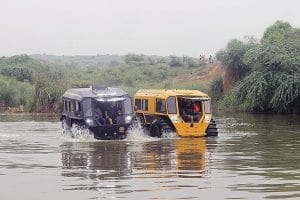
Sherp International has made its presence felt in India with a range of experiential drives beginning in the second half of 2021. Proudly bearing the badge of an international quality standards certificate ISO 9001, the Russian pedigree of the Sherp N 1200 (Sherp) is evident from the moment you come in the point-blank range of this behemoth of a machine. It humbles you with its sheer presence. It is tailor-made for niche applications like in the Border Security Force (BSF), for the Indian army besides in disaster management and rescue operations. It also makes a use case for private enterprises as a special application vehicle. Designed and built by Quadro International, in Ukraine, two units of the Sherp N 1200 are known to be on pilot runs with the armed forces in terrains like Bhuj, in Gujarat, for instance.
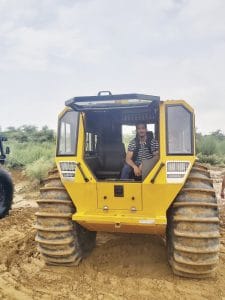
Motivated to provide a solution for tough terrains like Pangong Tso or Pangong Lake, a landlocked terrain spanning across eastern Ladakh and West Tibet situated at an elevation of 4,225 m, it was Jaskirat Singh Nagra, Chief Executive Officer and Founder at Chandigarh-based Sarbloh Motors who stumbled upon the Sherp. Today he represents Sherp International in India and deems it an apt time to induct the vehicle especially given the increased presence of the Indian armed forces in unforgiving terrains. His army background is known to have been the biggest motivator for him zeroing in on the Sherp. “I started looking for a vehicle designed and engineered to tackle extreme environments and terrains like the Pangong Tso and in that process, I came upon Sherp which according to me is a perfect match,” he opined. Nagra set the expectations straight up when he put a price tag on the machine. The Sherp N 1200 commands a whopping Rs.1.3 crore inclusive of the customs duty and miscellaneous costs like homologation.
A humbling footprint
The Sherp ferry’s nine people with ease owing to its generous dimensions. It measures 3962 mm in length. It is 2438 mm wide and looks down on you from a 2743 mm tall stance. From this point, one can’t ignore the front fascia. It boasts of utilitarian inclusions like the towing pin, an openable windshield for a front ingress, and heavy-duty LED headlamps protected by a mesh arrangement. The Sherp tips the scales at 2.4 tonnes with a 1.2 tonne rated payload and a towing capacity of 2.35 tonnes. Sherp has provided a towing hitch at the front and at the rear. Notably, the tyres are imposing too when looked at in isolation. The 1800×600-25 off-road tyres built in-house stand tall at 1828 mm lending to the rugged, utilitarian persona. It’s the tyres that hold the gigantic structure and equip the Sherp to get past any obstacle with monstrous ease. It is rather easy to trace the Sherp at least on land given that the unusually protruding treads are certain to leave a trail. The tyres run on a low 1.5 PSI pressure on the tarmac in a unique ability and a lower 0.5 PSI when submerged in waterbeds. They double up as suspension on the surface and help the Sherp stay afloat in water with the protruding treads emulating paddles.
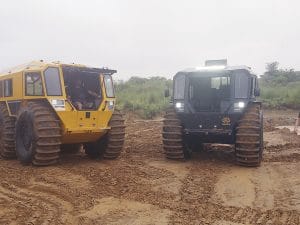
Explained Alexey Opanseasenko, International Sales Representative at Sherp, that the tyres are designed to eliminate the need of a conventional suspension arrangement. This phenomenon is termed as the ‘Pneumo Circulating Vibration-Damping Suspension’ in which the pressure of all the four tyres is said to be linked internally in a circuit arrangement. The circuit is claimed to adapt to surface undulations on either side and is known to be made up of a wheel-cushioning system. This is in turn connected to the wheel tyres, and a reservoir having a changeable volume. The air manifold forming that circuit or loop is connected to each tyre through air pipes, rotation and sealing units. Add to it, the tyres can also be inflated from within the cabin by exhaust gases. It takes 60 seconds to fully inflate the tyres. Notably, the tyres are moved by chains submerged in oil at all times, for minimising operational wear of the internal components. The Sherp boasts of a 2133 mm wheelbase sans overhang on the front or the rear in keeping with the practicality, performance and overall style sheet. The ATV is naturally as effective on land, lose soil or water; uphill or downhill as an amphibian vehicle could be imagined.
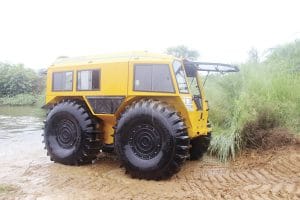
Utility and Driveability
To test the claims of its benchmark utility and driveability, I had to first figure out a way to enter the cockpit. Far from the conventional side-ingress, one has to climb through the nose with the help of the smartly placed handlebars that give a good grip. The cockpit of the Sherp is rather unconventional as the steering wheel is amiss! Settle into the driver seat and you are assured of safety with the three-point seatbelt. This is also extended to the passengers. You get an instant sense of control with a high arching view, and the hardtop providing shelter. The gloveboxes and cup holders are within easy reach. There is a relatively small digital cluster, and a tall lever akin to a joystick that must be used to steer. The access to the rear camera is helpful in plugging the blind spots. The L-shaped symmetrical arrangement of switches to the left of the pilot makes it the true spartan cockpit that it is.
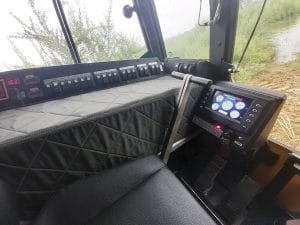
As intimidating it may seem at first to manoeuvre by just the lever, the learning curve is not that steep. It makes for a joyful ride experience despite the workhorse that the Sherp is. The unit handed to us was a Left Hand Drive (LHD) and could take a slight adjustment before one enters the comfort zone. The skid steer at this stage introduced me to a fun element of the ride. The Sherp with the help of the skid steer moves about its axis in a drool-worthy manoeuvre. It helps negotiate with the tricky spots one stands to encounter courtesy of the difference in speeds between the left and the right set. The non-orientable wheels attached to the skid steer are fixed and remain in a straight axis compared to the body axis thus allowing the Sherp to skid on demand. It of course requires the pilot to gain the requisite level of expertise and succeed at confidence-building manoeuvres as we witnessed.
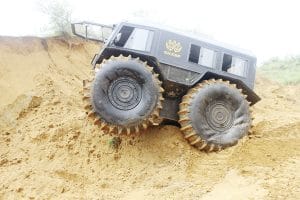
One seldom feels any undulations on the Sherp. The ATV lived up to its repute as it took on boulders, rough patches, rocks and stunted concrete hurdles of three to four feet height, passing over with ease. The gradeability of 35-degrees helped! It would be apt here to draw attention to the rugged exterior as well. A hot dipped steel frame and bottom, and the aluminium cabin make up the Sherp’s skeletal structure. The Docol high strength steel is claimed to withstand a force of 1000 Mpa (for more perspective, a normal passenger car with high strength steel used in critical areas for the protection of the occupants can withstand a force of 550 Mpa). It is coated with a layer of Raptor polyurethane with self-healing, water repellent, and soundproofing qualities. The coat resists any mechanical and corrosive damage. The roll cage is also made of Docol high strength steel with an additional layer of zinc. It is claimed to extend the service life by 30 years.

All the raw power to pull this machine is made available by a Stage 5 (Tier4 Final) compliant 1.8-litre, three-cylinder D18 diesel engine (comes with a warranty of 3000 hours) from the South Korean engine manufacturer Doosan. It is mated to a six-speed mechanical Renault JR5 transmission unit that offers an extreme crawl ratio for tricky traversals. The Sherp churns out a peak rated power of 55 hp and a rated peak torque of 190 Nm with revs locked at 3000 rpm. The torque is applied to the four wheels by chains sealed in a hermetic chamber filled with oil. With its mass, the Sherp can still attain a top speed of 40 kmph while crawling at two kilometres per hour on the other end of the spectrum. It draws fuel from a primary 95-litre fuel tank supplemented by an additional four fuel canisters mounted in the deep dish of the wheel hub each with a 58-litre capacity. This translates to a cumulative 327-litre capacity and an operating range of 61 hours considering the fuel consumption of five to eight litres per hour. The first drive has a maintenance interval of 50 hours post which the service intervals extend to over 250 hours. Had it not been the centre of gravity, the behemoth of a machine could well have tamed the skies. Interesting prospects lie ahead for the Sherp N 1200.
……………………………………………………….
Visit our YouTube channel to watch the exclusive interaction with Jaskirat Singh Nagra,
CEO and Founder at .Sarbloh Motors.

























